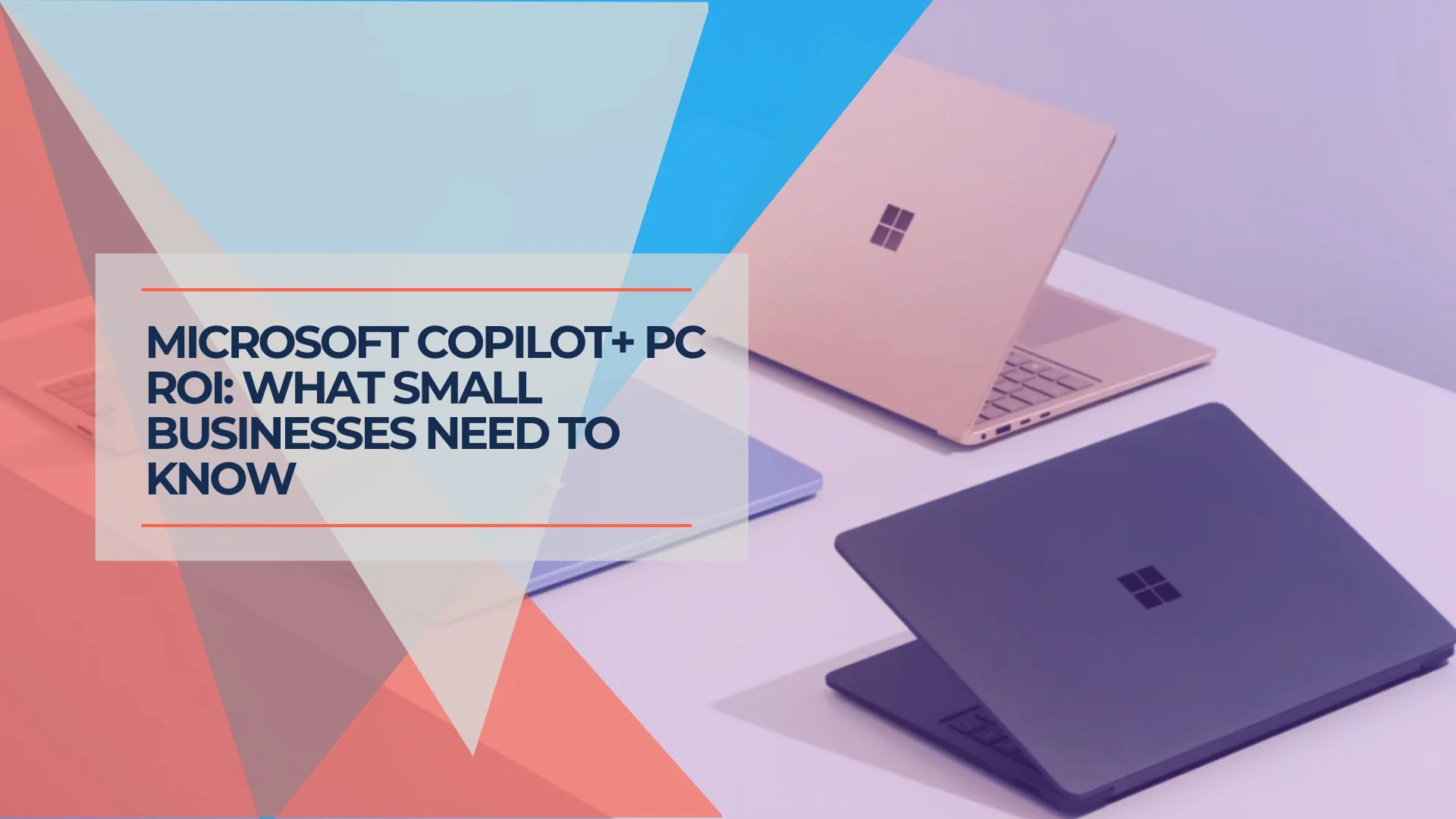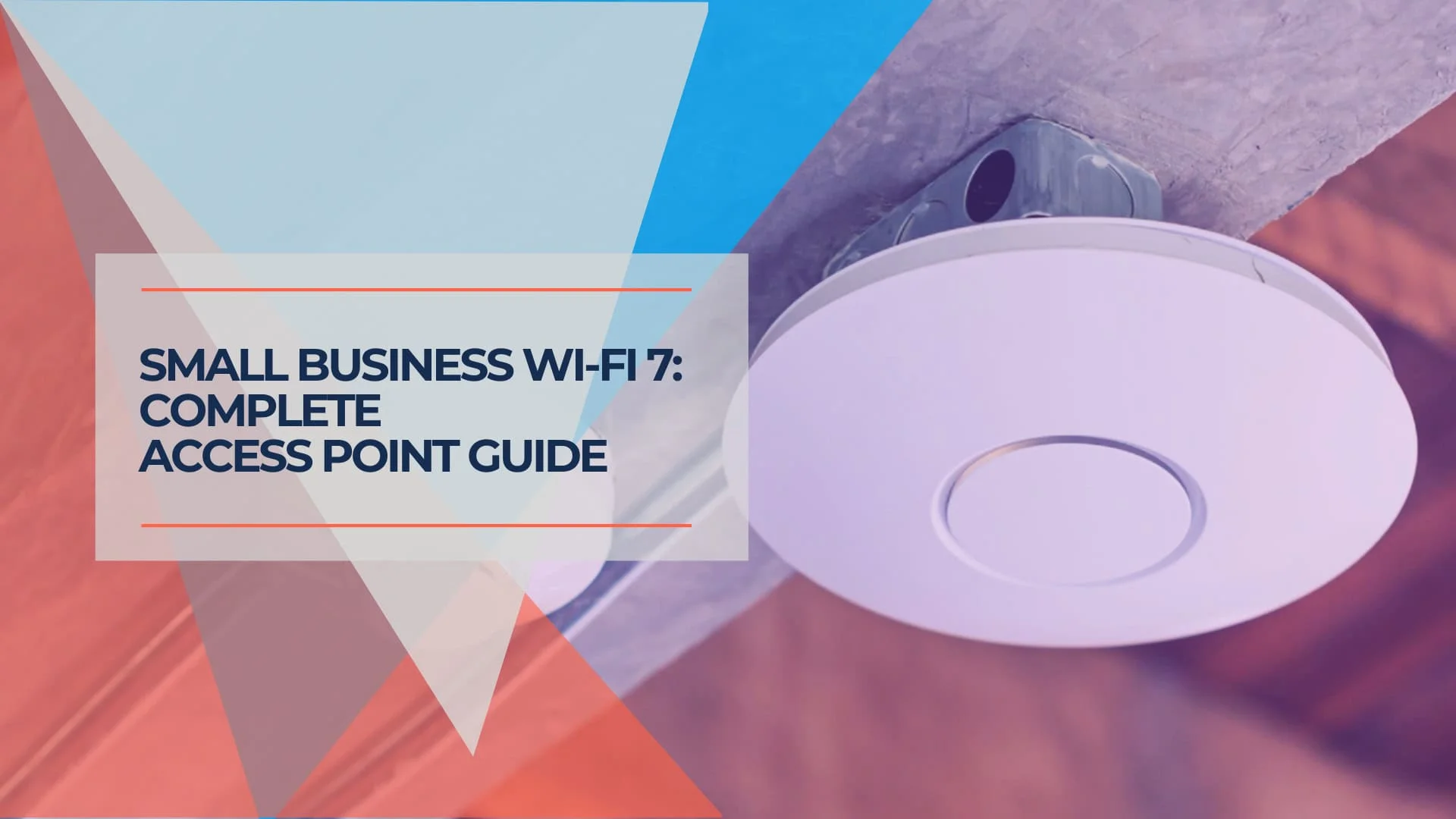Understanding Computer Specifications for Business Use: What Actually Matters
Complete guide to business computer specifications in 2025. Learn which processor, RAM, storage, and display specs actually impact productivity and how to choose the right configuration for your team.


Choosing the right computer for your business shouldn't feel like decoding a foreign language. While technology specifications can seem overwhelming, understanding which components actually impact your daily productivity—and which are just marketing buzzwords—can save your organization thousands of dollars while ensuring your team has the tools they need to succeed. This guide cuts through the technical jargon to focus on what really matters for business computing in 2025.
Key Takeaways
- Processor Performance: Modern Intel Core i5 or AMD Ryzen 5 processors provide sufficient power for most business applications without premium pricing
- Memory Requirements: 16GB RAM represents the current sweet spot for business productivity, with 8GB adequate for basic tasks and 32GB for demanding workflows
- Storage Strategy: Solid State Drives (SSDs) deliver the most noticeable performance improvement for daily business operations
- Display Considerations: 14-15 inch screens with Full HD resolution balance portability with productivity for mobile professionals
- Battery Life: 8-10 hours of real-world usage ensures full-day productivity without constant charging concerns
- Connectivity Standards: USB-C, WiFi 6E, WiFi 7, and Bluetooth 5.0+ provide future-proof connectivity for modern business environments
Quick Reference: Business Computer Specifications Guide
| Component | Basic Office | Professional | Power User |
|---|---|---|---|
| Processor | Intel Core i3 / AMD Ryzen 3 | Intel Core i5 / AMD Ryzen 5 | Intel Core i7 / AMD Ryzen 7 |
| Memory (RAM) | 8GB | 16GB | 32GB |
| Storage | 256GB SSD | 512GB SSD | 1TB SSD |
| Display | 13-14" Full HD | 14-15" Full HD | 15-16" QHD/4K |
| Battery Life | 6-8 hours | 8-10 hours | 8-12 hours |
| Price Range | $600-$900 | $900-$1,400 | $1,400-$2,200 |
Understanding Processor Performance for Business Applications
The processor serves as your computer's brain, handling computational tasks from opening applications to processing data. Understanding processor capabilities helps ensure smooth operation of essential software without overspending on unnecessary performance for business use.
Current Processor Landscape (2025)
Intel's 15th-generation Arrow Lake processors (Core Ultra 200 series) and AMD's Ryzen 8000/9000 series represent the cutting-edge platforms for business computing. Intel has transitioned from the traditional Core i3/i5/i7 naming to Core Ultra 3/5/7/9, featuring a sophisticated tri-core architecture with P-cores, E-cores, and LP-cores, while AMD continues advancing with Zen 5 architecture and enhanced AI capabilities.
Processor Technology Updates
Intel 15th Generation Arrow Lake: The Core Ultra 9 285H features 6 P-cores, 8 E-cores, and 2 LP-cores with boost clocks up to 5.4 GHz and integrated Arc 140T graphics. Business-focused processors like the Core Ultra 5 225H and Core Ultra 7 255H provide balanced performance with 20W+ TDP for excellent battery life and thermal efficiency.
AMD Ryzen 8000/9000 Series: The Ryzen 9 8945HX delivers 16 cores and 32 threads with 5.4 GHz boost clocks, while the Ryzen Pro 8040 series targets commercial deployments with enhanced security features and NPU integration for AI workloads.
Processor Performance Tiers
Entry Level (Core Ultra 3/Ryzen 3): Suitable for basic office tasks including email, web browsing, document editing, and light spreadsheet work. These processors handle Microsoft Office applications efficiently with improved power efficiency over previous generations, though they may struggle with multiple demanding applications running simultaneously.
Professional (Core Ultra 5/Ryzen 5): The sweet spot for most business users, providing excellent performance for multitasking, video conferencing, moderate data analysis, and running multiple browser tabs with business applications. The Core Ultra 5 225H offers 4 P-cores and 8 E-cores with 20W+ TDP, while Ryzen 5 variants deliver superior multicore performance for productivity workflows.
Power User (Core Ultra 7-9/Ryzen 7-9): Designed for demanding business applications, including advanced data analysis, content creation, software development, and running virtual machines. The Core Ultra 9 285H and Ryzen 9 8945HX handle complex spreadsheets, database operations, and professional software suites with exceptional performance, featuring up to 16 cores and integrated AI acceleration capabilities.
Market Pricing and Value Analysis (2025)
Business laptop pricing reflects competitive market dynamics with significant value improvements across all segments. Major manufacturers have optimized price-to-performance ratios while incorporating advanced technologies like OLED displays and AI-accelerated processors.
Current Market Pricing:
- Value Business ($179-$799): Dell XPS 13 at $799 with Core Ultra 5, 16GB RAM, 512GB SSD, 2K display – exceptional value for premium specifications
- Professional ($800-$1,400): ThinkPad T14s Gen 6 and HP Pavilion Plus 14 with OLED displays, enhanced battery life, and mobile optimization
- Executive Premium ($1,400-$2,200): ThinkPad X1 Carbon Gen 13 with OLED, Dell XPS 16 for creative professionals, advanced display technology
- Workstation ($2,200+): 16.3-inch OLED workstations with 3.2K resolution, 64GB RAM, specialized for technical and creative professionals
Real-World Performance Considerations
Processor specifications often include technical details that don't directly translate to business performance. Focus on these practical aspects:
- Core Count: Modern business applications benefit from 4-8 cores, allowing smooth multitasking between email, web browsers, and productivity software
- Base Clock Speed: 2.4-3.0 GHz provides adequate performance for most business tasks without excessive power consumption
- Integrated Graphics: Built-in graphics handle business applications, video conferencing, and multiple monitors without requiring dedicated graphics cards
- Power Efficiency: Modern processors balance performance with battery life, crucial for mobile business users
Memory (RAM): The Foundation of Smooth Operations
Random Access Memory (RAM) impacts the number of applications you can run simultaneously and how quickly they respond. Insufficient memory creates bottlenecks that slow down workflows, while excessive memory provides minimal benefit for typical business use.
DDR5 Memory Requirements for Business Computing
DDR5 RAM has become the universal standard for business laptops in 2025, delivering significant performance improvements over DDR4 while addressing the evolving memory demands of modern professional computing environments. The transition to DDR5 technology provides enhanced multitasking capabilities, faster data processing, and future-proof performance essential for contemporary business workflows.
DDR5 Technical Advantages
DDR5 operates at higher frequencies with better power efficiency, delivering faster data transfer rates and reduced latency. Modern business laptops feature dual-channel DDR5 architecture with user-upgradeable configurations, providing strategic flexibility for organizations to adapt to evolving software requirements.
Memory Configuration Standards
16GB DDR5: New Business Baseline
The new baseline requirement for business users in 2025 represents a significant shift from the previous 8GB standards. It effectively handles multiple browser tabs, office productivity suites, video conferencing applications, and basic multitasking scenarios.
Suitable for: General business users, managers, sales professionals, and most office-based roles requiring standard multitasking capabilities
32GB DDR5: Professional Standard
The optimal balance between performance and cost-effectiveness for demanding business applications. Accommodates creative professionals, technical specialists, and power users working with resource-intensive applications, virtual machines, large datasets, or complex development environments.
Suitable for: Data analysts, financial modelers, software developers, content creators, and users running specialized business software
64GB DDR5: Workstation Class
Workstation-class configurations for specialized business applications requiring maximum memory capacity. Serves professionals working with AI model training, extensive 3D rendering, large-scale data analysis, or complex engineering simulations.
Suitable for: Technical specialists, AI developers, 3D designers, and professionals requiring maximum memory capacity for specialized workflows
Storage Solutions: Speed vs. Capacity for Business Needs
Storage technology impacts daily computer performance, affecting boot times, application loading, and file access speeds. Understanding storage options helps balance performance requirements with capacity needs and budget constraints.
NVMe SSDs: The 2025 Business Standard
NVMe SSDs have become the standard for business computers in 2025, offering superior performance over traditional SATA SSDs. NVMe technology utilizes PCIe interfaces and transfers 25x more data than SATA equivalents, with commands that are 2x faster than AHCI drivers. These benefits directly impact productivity:
- Boot Performance: Systems start in 10-20 seconds with modern NVMe drives
- Application Loading: Business software launches up to 900% faster than traditional storage solutions
- File Operations: Modern NVMe drives achieve over 2 million IOPS for instantaneous file access
- Reliability: No moving parts reduce failure risk and improve durability for mobile business use
- Power Efficiency: Advanced power management extends battery life for laptop users
PCIe 4.0 vs PCIe 5.0
PCIe 4.0 NVMe SSDs remain the practical standard for business laptops, offering excellent performance for typical workflows. PCIe 5.0 technology provides up to 2x faster speeds but carries significant cost premiums, making it suitable primarily for specialized applications like content creation, data analytics, and development environments requiring maximum I/O performance.
Storage Capacity Standards
512GB NVMe SSD: Entry-Level Configuration
Entry-level configuration for basic business computing, though increasingly insufficient for modern applications. Windows 11 and business software suites require approximately 160GB, leaving limited space for user data and system operations.
Suitable for: Basic office tasks, cloud-based workflows, and budget-conscious deployments
1TB NVMe SSD: New Business Standard
The new standard for business laptops in 2025, providing adequate space for operating systems, productivity suites, and moderate local storage requirements.
Suitable for: Most business users requiring local file storage and application flexibility
2TB+ NVMe SSD: Professional Standard
The optimal balance between cost and capacity for demanding business applications. Accommodates extensive software installations, local databases, virtual machines, and substantial file storage.
Suitable for: Data analysis, content creation, software development, and users with extensive local storage requirements
4TB+ NVMe SSD: Workstation Class
Workstation-class configurations for specialized business applications requiring maximum storage capacity. Serves professionals working with large datasets, extensive media libraries, or complex development environments.
Suitable for: Technical specialists, data scientists, video editors, and professionals requiring maximum storage capacity
Display Technology: Balancing Productivity and Portability
Display specifications impact daily productivity, eye comfort, and user experience. Understanding display technology helps select systems that support business workflows effectively.
Display Technology for Business Use (2025)
Display technology has evolved significantly, with OLED panels, high refresh rates, and enhanced resolution standards becoming mainstream in business laptops. These advances directly impact productivity, visual comfort, and professional workflow efficiency.
Screen Size and Form Factor:
- 13-14 inch: Premium OLED options like Dell Pro 13 with QHD tandem OLED (2560×1600), achieving 21+ hour battery life
- 15-16 inch: Advanced displays like Samsung Galaxy Book 5 Pro with 2880×1800 AMOLED and 48-120Hz variable refresh rates
- 17+ inch: Workstation-class 16.3-inch OLED displays with 3.2K resolution and touch capability for demanding professional applications
Resolution Standards and Visual Quality
QHD OLED (2560×1600): New Business Standard
The new standard for premium business laptops, offering enhanced pixel density without the processing demands of 4K. Tandem OLED implementations provide exceptional battery efficiency while maintaining superior visual quality for professional workflows.
Advantages: Superior contrast ratios, accurate color reproduction, enhanced battery efficiency, and professional-grade visual clarity
4K OLED (3840×2160): Professional Grade
Professional-grade displays covering 80% Adobe RGB and achieving 530+ nits brightness. Four times the pixel density of 1080p with 100% DCI-P3 color coverage for color-critical business applications and content creation workflows.
Consider for: Design work, content creation, detailed data analysis, and users requiring maximum visual precision
Advanced Display Features
Modern business displays feature cutting-edge technologies that significantly enhance productivity:
- Tandem OLED: Premium business laptops feature advanced tandem OLED technology, delivering superior contrast and color accuracy while achieving exceptional battery life exceeding 25 hours
- Variable Refresh Rate (48-120Hz): Adaptive refresh rates provide smooth scrolling and reduced eye strain while optimizing power consumption
- Professional Color Standards: Business OLED displays achieve 100% DCI-P3 color coverage and 85%+ Adobe RGB
- Anti-glare coatings: Reduce reflections in bright office environments while maintaining OLED visual quality
- Blue light reduction: Hardware-level filtering reduces eye strain during extended computer use
Battery Life and Power Management
Battery performance affects mobile productivity and user flexibility. Understanding real-world battery expectations helps ensure systems meet actual business usage patterns.
Real-World Battery Performance
Manufacturer battery life claims often reflect ideal conditions that don't match typical business use. Realistic expectations for business computing:
Typical Business Usage Patterns:
- Light Usage (8-10 hours): Email, web browsing, document editing with screen brightness at moderate levels and WiFi connectivity
- Moderate Usage (6-8 hours): Video conferencing, multitasking between applications, moderate screen brightness, and mixed connectivity
- Heavy Usage (4-6 hours): Continuous video conferencing, high screen brightness, multiple demanding applications, and extensive processor usage
Power Management Features
Modern business computers include power management features that extend battery life and improve user experience:
- Adaptive brightness: Automatically adjusts screen brightness based on ambient lighting conditions
- Processor scaling: Reduces processor speed during light tasks to conserve battery power
- Sleep and hibernation: Quickly suspend operations when not in use while preserving work sessions
- Fast charging: Rapid charging capabilities minimize downtime during brief charging opportunities
Connectivity and Expansion Options
Connectivity options determine how computers integrate with existing business infrastructure and support future technology adoption.
Essential Connectivity Standards
Thunderbolt 5: Next-Generation Universal Connectivity
Thunderbolt 5 ports deliver unprecedented bandwidth up to 120 Gbps with Bandwidth Boost technology, supporting multiple high-resolution displays and high-speed storage simultaneously. Modern business computers increasingly feature Thunderbolt 5 for maximum versatility and future-proofing.
Benefits: 120 Gbps peak bandwidth, 240W power delivery, DisplayPort 2.1 support, and backward compatibility with USB4 V2
WiFi 7: Revolutionary Wireless Performance
WiFi 7 provides up to 5.19 Gbps throughput with 320MHz channels and Multi-Link Operation (MLO) for dramatically reduced latency. Essential for businesses requiring high-bandwidth wireless connectivity and real-time collaboration applications.
Advantages: Multi-gigabit wireless speeds, ultra-low latency, enhanced reliability through MLO, and superior performance in dense environments
Legacy and Transitional Connectivity
While cutting-edge standards like Thunderbolt 5 and WiFi 7 offer superior performance, business environments often require transitional connectivity during technology adoption cycles:
- USB4 V2 ports: Full Thunderbolt 5 compatibility with enhanced peripheral support and DisplayPort 2.1 integration
- USB-A ports: Support existing peripherals and accessories without requiring adapters during transition periods
- HDMI 2.1 output: Direct connection to high-refresh displays and conference room equipment with 4K@120Hz support
- 2.5 Gigabit Ethernet: Enhanced wired connectivity for high-performance networking and secure connections
- Audio jack: Headset connectivity for video conferencing and professional audio applications
Security Features for Business Computing
Business computers require security features that protect sensitive data and ensure compliance with organizational policies.
Hardware-Based Security
TPM (Trusted Platform Module)
TPM chips provide hardware-based security for encryption keys, passwords, and digital certificates. TPM 2.0 is essential for Windows 11 business deployments and advanced security features, including BitLocker encryption.
Business Benefits: Secure boot processes, hardware-based encryption, and compliance with enterprise security policies
Biometric Authentication
Modern business computers often include biometric authentication options that improve security while enhancing user convenience:
- Fingerprint readers: Quick and secure login without password entry
- Facial recognition: Hands-free authentication using built-in cameras
- Smart card readers: Integration with existing enterprise authentication systems
Business Computer Blueprints: Matching Specifications to Roles
Different business roles require different computer specifications. These blueprints provide practical guidance for common business scenarios.
Essential Office Blueprint
For Basic Business Tasks and Budget-Conscious Deployments
| Specification | Recommendation |
|---|---|
| Processor | Intel Core i3-1315U or AMD Ryzen 3 7330U |
| Memory | 8GB DDR4 RAM |
| Storage | 256GB SSD |
| Display | 14" Full HD (1920×1080) |
| Battery | 6-8 hours typical usage |
| Connectivity | WiFi 6, Bluetooth 5.0, USB-C, USB-A |
Suitable Applications: Email, web browsing, Microsoft Office, basic accounting software, and single-task workflows
Example Systems: Lenovo ThinkPad E14 Gen 6 ($700-$850), Dell Inspiron 14 ($650-$750), ASUS VivoBook 14 ($600-$700)
Total Cost of Ownership: $700-$850 initial investment with 4-5 year expected lifespan
Professional Productivity Blueprint
For Standard Business Users and Mobile Professionals
| Specification | Recommendation |
|---|---|
| Processor | Intel Core i5-1340P or AMD Ryzen 5 7540U |
| Memory | 16GB DDR4/DDR5 RAM |
| Storage | 512GB SSD |
| Display | 14-15" Full HD with anti-glare coating |
| Battery | 8-10 hours typical usage |
| Connectivity | WiFi 6E, Bluetooth 5.1, multiple USB-C, HDMI |
Suitable Applications: Multitasking, video conferencing, moderate data analysis, CRM systems, and mobile productivity
Example Systems: Lenovo ThinkPad T14 Gen 6 ($1,050-$1,350), Dell Latitude 5440 ($950-$1,250), HP EliteBook 1040 ($1,100-$1,400)
Total Cost of Ownership: $1,050-$1,350 initial investment with 5-6 year expected lifespan
Power User Blueprint
For Demanding Applications and Specialized Workflows
| Specification | Recommendation |
|---|---|
| Processor | Intel Core i7-1360P or AMD Ryzen 7 7740U |
| Memory | 32GB DDR5 RAM |
| Storage | 1TB SSD |
| Display | 15-16" QHD (2560×1440) or 4K |
| Battery | 8-12 hours with power management |
| Connectivity | WiFi 6E, Bluetooth 5.2, Thunderbolt 4, multiple ports |
Suitable Applications: Data analysis, software development, content creation, virtual machines, and complex modeling
Example Systems: Lenovo ThinkPad X1 Carbon Gen 13 ($1,650-$2,200), Dell XPS 15 ($1,500-$2,050), HP ZBook Studio ($1,700-$2,350)
Total Cost of Ownership: $1,650-$2,200 initial investment with 6-7 year expected lifespan
2025 Technology Trends Impacting Business Computing
Several technology trends are shaping business computer specifications and purchasing decisions in 2025.
AI-Enhanced Processors
Neural Processing Units (NPUs) are becoming standard in business processors, enabling on-device AI processing for applications like intelligent document processing, real-time language translation, and enhanced video conferencing features.
Hybrid Work Optimization
Manufacturers are optimizing systems for hybrid work scenarios with improved cameras, microphones, and speakers for video conferencing, along with better wireless connectivity and battery management for mobile use.
Sustainability Focus
Business computers increasingly emphasize energy efficiency, recyclable materials, and longer product lifecycles to meet corporate sustainability goals and reduce total cost of ownership.
Total Cost of Ownership Analysis
Understanding the complete cost of business computer ownership helps make informed purchasing decisions that balance initial investment with long-term value.
5-Year TCO Comparison
| Configuration | Initial Cost | Annual Support | 5-Year Total |
|---|---|---|---|
| Budget Configuration | $750 | $120 | $1,350 |
| Professional Configuration | $1,200 | $100 | $1,700 |
| Power User Configuration | $1,850 | $80 | $2,250 |
Higher-specification systems often provide better long-term value through improved productivity, reduced support requirements, and longer useful lifecycles.
Frequently Asked Questions
Should I choose Intel or AMD processors for business use?
Both Intel and AMD offer excellent processors for business applications. Intel traditionally provides better compatibility with business software and management tools, while AMD often offers superior performance per dollar. For most business users, either option provides adequate performance, making price and specific feature requirements the primary decision factors.
Is 8GB of RAM sufficient for business use in 2025?
8GB RAM remains adequate for basic business tasks, including email, web browsing, and simple document editing. However, 16GB has become the recommended standard for professional use, providing comfortable performance for multitasking, video conferencing, and running multiple business applications simultaneously. Consider 8GB only for budget-constrained deployments with basic usage requirements.
How important is SSD storage for business computers?
SSD storage provides the most noticeable performance improvement for daily business operations. The speed difference between SSDs and traditional hard drives significantly impacts boot times, application loading, and file operations. SSD storage is strongly recommended for business use regardless of capacity constraints, as the productivity benefits justify the additional cost.
What screen size is best for business laptops?
Screen size depends on primary usage patterns. 14-15-inch displays offer the best balance of productivity and portability for most business users. 13-inch screens maximize portability for frequent travelers but may limit productivity for extended desk work. 16+ inch screens provide maximum workspace but reduce portability for mobile business use.
How long should business computers last?
Well-specified business computers typically provide 4-6 years of productive service. Professional-grade systems with adequate specifications often exceed this timeframe, while budget configurations may require replacement sooner due to performance limitations with evolving software requirements. Proper maintenance and appropriate initial specifications significantly impact useful lifespan.
Are touchscreen displays worth the additional cost for business use?
Touchscreen displays add cost, weight, and potential reliability concerns while providing limited benefit for typical business applications. Most business software is optimized for keyboard and mouse input rather than touch interaction. Consider touchscreens only for specific applications requiring touch input or presentation scenarios where direct screen interaction provides clear advantages.
What connectivity options are essential for business laptops?
Essential connectivity includes multiple USB ports (both USB-A and USB-C), WiFi 6 or newer, Bluetooth 5.0+, and HDMI output for presentations. USB-C ports should support power delivery and display output for maximum versatility. Ethernet ports provide valuable backup connectivity, while SD card readers benefit users working with media files.
Should I prioritize battery life or performance for business laptops?
The optimal balance depends on usage patterns. Mobile professionals should prioritize battery life to ensure full-day productivity without charging constraints. Desk-based users can emphasize performance since power outlets are readily available. Modern processors provide good efficiency, making it possible to achieve both reasonable performance and adequate battery life in most business configurations.
Implementation Strategy and Purchasing Considerations
Successful business computer deployments require careful planning, considering immediate and future needs.
Standardization Benefits
Standardizing on specific computer models and configurations provides several business advantages:
- Simplified Support: Technicians become familiar with common hardware configurations, reducing troubleshooting time
- Volume Pricing: Purchasing multiple identical systems often provides better pricing and warranty terms
- Inventory Management: Standardized components and accessories simplify spare parts inventory
- User Training: Consistent interfaces reduce training requirements when users switch between systems
Phased Deployment Approach
Large computer deployments benefit from phased implementation:
- Phase 1: Pilot deployment with key users to validate specifications and identify issues
- Phase 2: Department-by-department rollout based on business priorities and budget availability
- Phase 3: Complete deployment with lessons learned from earlier phases
- Phase 4: Ongoing refresh cycle based on system lifecycle and business needs
Ready to Upgrade Your Business Computing?
Selecting appropriate computer specifications requires balancing performance requirements, budget constraints, and future business needs. Professional assessment ensures your technology investment supports rather than limits business productivity.
Our team provides comprehensive computer specification analysis, vendor evaluation and procurement assistance, deployment planning and implementation, ongoing support and maintenance planning, and technology refresh cycle management.
Affiliate Disclosure: This article contains affiliate links. If you make a purchase through these links, we may earn a small commission at no extra cost to you.
Related Articles
More from Business Hardware

Copilot+ PCs for Business: Worth the Investment in 2025?
Evaluate whether Copilot+ PCs deliver real ROI for small businesses. Expert analysis of AI-powered laptops, productivity benefits, and investment considerations.
10 min read

The 10 Best Business Laptops for Fall 2025: A Complete SMB Buying Guide
Complete guide to the best business laptops for Fall 2025. Compare ThinkPad X1 Carbon, MacBook Air M4, Dell 14 Plus, and more with detailed specs, pricing, and use case recommendations.
18 min read

Best WiFi 7 Access Points for Small Business
Wi-Fi 7 brings transformational speed and capacity improvements. Discover the best access points for small businesses, including UniFi U7 Pro XGS, TP-Link Omada EAP783, and more.
15 min read